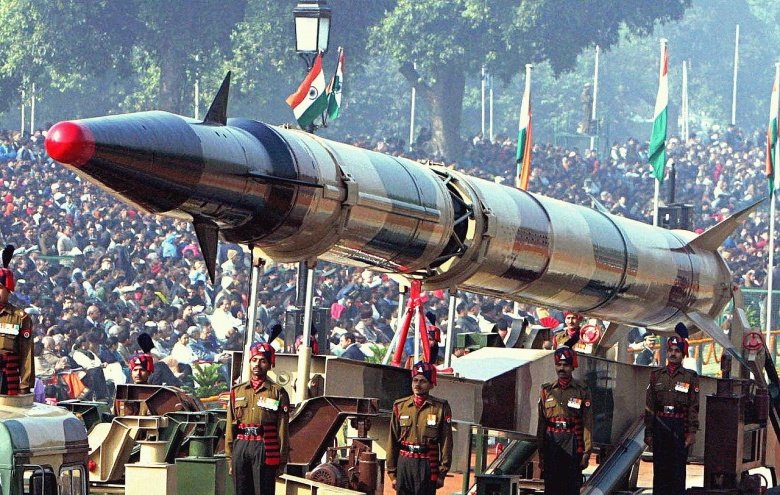
Source: The National Interest
Anum A. Khan
The December 20, House of Commons Library’s Briefing Paper for the UK Parliament identifies India as a self-declared Nuclear Weapon State (NWS) which continues to produce weapon- grade fissile material and is estimated to have a growing arsenal of 150 warheads.
In 2016, the Institute of Strategic Studies Islamabad (ISSI) published a book in which independent analysts provided conservative assessments on India’s optimal capacity to produce nuclear weapons from assessed unsafeguarded reactor-grade plutonium (RG Pu) and weapon grade plutonium (WG Pu) stocks. According to the estimates in the book, India can produce at least 356 to 492 nuclear weapons. Interestingly, the estimates in the book were concluded using primary Indian sources of reference which make it a more credible assessment. Nevertheless, these estimates were made in 2016, suggesting a continuous and unhindered increase in Indian capacity to produce nuclear weapons. According to SIPRI estimates, India has HEU (4.4 tons) and Pu (6.5 tons—if, 0.4 tons are not included, as they are under safeguards). If calculated, Indian HEU and Pu is basically enough to produce roughly 1,876 nuclear weapons. These are six times more than Pakistan’s estimated capability.
In terms of Indian nuclear policy, the paper suggests that India’s continuous increase of its nuclear stockpile and modernization of its nuclear arsenal is to provide it preemptive capabilities. These Indian capabilities are contradictory to capabilities required for Indian commitment to Credible Minimum Deterrence (CMD) and No First Use (NFU) policy. India has been on the road to acquire first strike capabilities for two decades now. India has an offensive sea-based capability nuclearizing the Indian Ocean Region (IOR), Multiple Independently Targetable Reentry Vehicles (MIRV), Intercontinental Ballistic Missiles (ICBMs) and Canister-Based Missiles (Agni V). Moreover, the Indian strategic thinking to move away from its NFU and massive retaliation is evident from the development and deployment of Prahaar Short Range Ballistic Missiles. Indian Defence Minister Rajnath Singh also hinted at altering India’s nuclear policy of NFU. According to Harsh V. Pant and Yogesh Joshi, in case of a conflict,India will station its nuclear forces for preemptive strike purposes. Hence, Indian nuclear modernization and its persistent quest to acquire escalation dominance strategy against Pakistan is also in contrast to India’s declaratory nuclear policies.
This reaffirms Pakistan’s threat perception which, based on realities on ground, never gave credence to Indian NFU policy and termed it as rhetoric. Moreover, the paper highlights that, although, the guiding principle of Pakistan’s nuclear policies is Credible Minimum Deterrence, what Pakistan considers to be minimal, is guided by regional security considerations and the changing shape of India’s military forces. The paper also mentioned that, in 2013, Pakistan adopted the concept of Full Spectrum Deterrence (FSD), to deter all forms of aggression. It is pertinent to add here that Pakistan’s National Command Authority (NCA) has, time and again, reiterated that Pakistan’s policy of FSD in in line with its CMD. This doctrine of FSD is to retain all Indian counter value and counter force targets of strategic, operational, and tactical weapons within the striking range.
Major states like the U.S. turn a blind eye toward Indian developments because of two reasons. One, the U.S. containment policy sees India as a bulwark against China’s so-called expansionism. Two, India is a major market for major states for continuous fueling of their Military Industrial Complex. For India, its central tenet to acquire benefits in this great game between great powers is to play up the two-front war paranoia to expedite uninterrupted U.S’ economic, diplomatic, and military support.
Hence, unlike Pakistan, India has not many incentives to show restraint and responsibility. India is aspiring for a role of a regional policeman in the Indo-Pacific. India has already acquired majority of incentives from the international community which could have otherwise been used as quid-pro-quos to keep Indian nuclear modernization in check. For instance, India is a member of three out of the four Nuclear export control cartels. The U.S. is proactively whipping up diplomacy for Indian NSG membership , despite Pakistan’s continuous calls for following criteria- based approach for NSG membership of non-NPT states (mainly India and Pakistan). Till date, India also enjoys 13-plus nuclear deals with other states because of the 2005 Indo-U.S. nuclear deal. As mentioned in the paper, each ton of imported nuclear material frees Indian domestic nuclear material for nuclear weapons.
What remains unclear is this: how far is the U.S. willing to take India to become a global hegemon, before it directly threatens the U.S. itself while continuously eroding deterrence stability in South Asia? India plans for a global strike capability with 10,000 km range ballistic missiles. Agni VI is a step in that direction. As expressed in the report, Pakistan will obviously stop at a point where it feels it has enough to deter India. Nevertheless, considering Indian Aesopian nuclear struggle as a provocateur, whether the same applies to India is ill-fatedly uncertain.
Anum A. Khan is a visiting Senior Research Fellow of Strategic Vision Institute (SVI), Islamabad, and a PhD Scholar at Defense and Strategic Studies Department (DSS), Quaid-i-Azam University Islamabad.




